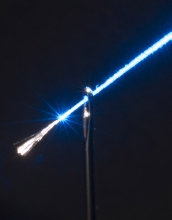|

Press Release 06-045
New Process Builds Electronics Into Optical Fiber

Advance could lead to building a range of devices inside tiny light transmitters
March 16, 2006
Scientists from Pennsylvania State University and the University of Southampton in the United Kingdom have demonstrated a new way to combine microelectronics and optical fibers--a development that opens up potential applications in fields as diverse as medicine, computing and remote sensing.
As they explain in the March 17 edition of the journal Science, the researchers have discovered how to fashion a thin, flexible tube of ultra-clear glass--an optical fiber--that has a hollow core packed with microscopic wires made of a semiconductor such as germanium. The scientists then created solid-state electronic devices, including a transistor, inside the semiconductors.
"This advance is the basis for a technology that could build a large range of devices inside an optical fiber," says Penn State chemist John Badding, one of the lead authors of the report.
Indeed, he says, it could help meet one of the greatest challenges in modern information technology. How do you rapidly and efficiently exchange information between optical fibers, which have proved to be the ideal medium for transmitting data (in the form of light pulses), and solid-state microelectronic devices, which are by far the most effective tools for manipulating and processing the data? "If the signal never leaves the fiber, then it is faster, cheaper and more efficient," says Badding.
"This fusion of two separate technologies opens the possibility of true optoelectronic devices that do not require conversion between optical and electronic signals," says University of Southampton optoelectronics expert Pier Sazio, another lead author. "If you think of the fiber as a water main, this structure places the pumping station inside the pipe. The glass fiber provides the transmission and the semiconductor provides the function."
Support for this research came from the National Science Foundation; the NSF-funded Penn State Center for Nanoscale Science; the Penn State-Lehigh Center for Optical Technologies; the U.K. Engineering and Physical Sciences Research Council; and the Mexican Council for Science and Technology.
For more details, see the Penn State news release.
-NSF-

Media Contacts
M. Mitchell Waldrop, NSF (703) 292-7752 mwaldrop@nsf.gov
David C. Evans, University of Southampton 44-2380-593-139 dce@orc.soton.ac.uk
Barbara K. Kennedy, Pennsylvania State University (814) 863-4682 science@psu.edu
Principal Investigators
Pier Sazio, University of Southampton 44-7884-444-429 pjas@soton.ac.uk
John Badding, Pennsylvania State University (814) 777-3054 jbadding@pearl.chem.psu.edu

The National Science Foundation (NSF) is an independent federal agency that
supports fundamental research and education across all fields of science and
engineering, with an annual budget of $6.06 billion. NSF funds reach all 50
states through grants to over 1,900 universities and institutions. Each year,
NSF receives about 45,000 competitive requests for funding, and makes over
11,500 new funding awards. NSF also awards over $400 million in
professional and service contracts yearly.
 Get News Updates by Email Get News Updates by Email
Useful NSF Web Sites:
NSF Home Page: http://www.nsf.gov
NSF News: http://www.nsf.gov/news/
For the News Media: http://www.nsf.gov/news/newsroom.jsp
Science and Engineering Statistics: http://www.nsf.gov/statistics/
Awards Searches: http://www.nsf.gov/awardsearch/
| 


